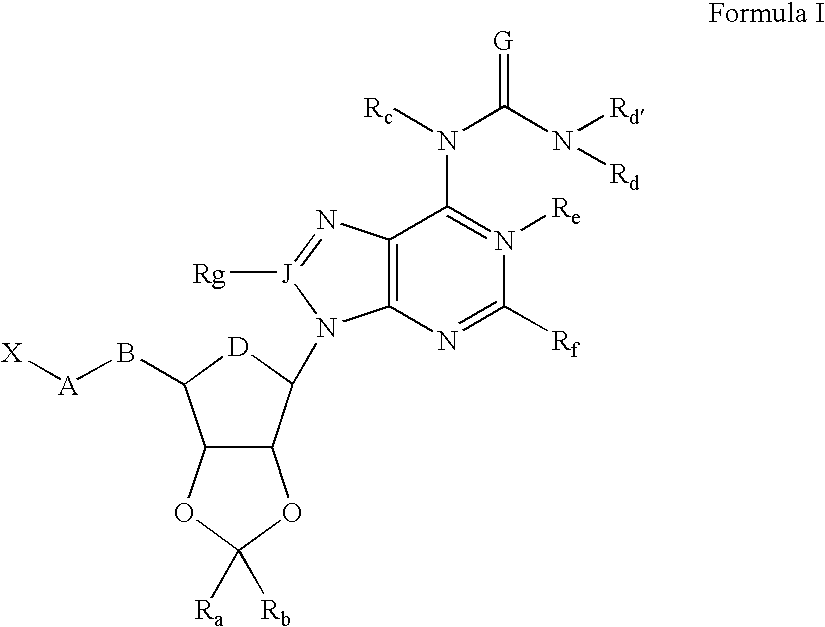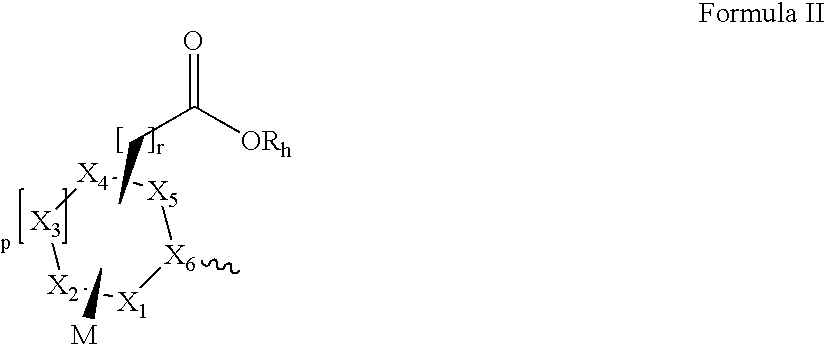Non-nucleotide composition and method for inhibiting platelet aggregation
a technology of platelet aggregation and composition, which is applied in the field of non-nucleotide compounds, can solve the problems of emboli that travel through the circulatory system, blockage of other vessels, pathological outcomes,
- Summary
- Abstract
- Description
- Claims
- Application Information
AI Technical Summary
Problems solved by technology
Method used
Image
Examples
example 1
Preparation of 5′-aryl ether derivatives
5-Amino-2-{2-benzyl-6-[6-(3-phenyl-ureido)-purin-9-yl]-tetrahydro-furo[3,4-d][1,3]dioxol-4-ylmethoxy}-benzoic acid (2)
[0327] Adenosine (10 g, 37 mmol was dissolved in N,N-dimethyl formamide (100 mL) and dimethoxypropane (25 mL) followed by addition of Amberlyst 15H+ resin. The mixture was stirred 3 h at 55° C. The resin was removed by filtration and the solvents removed in vacuo, affording 2′,3′-di-O-isopropylidene adenosine (11 g, 95%).
[0328] This product (6 g, 20 mmol) was dissolved in N,N-dimethyl formamide (22 mL) and stirred with triisopropylsilyl chloride and imidazole 16 h at 23° C. The solution was partitioned between ether (200 mL) and brine (100 mL) and the ether phase washed with additional brine (2×50 mL). The ether was dried over magnesium sulfate and evaporated, affording 5′-O-triisopropylsilyl-2′,3′-di-O-isopropylidene adenosine.
[0329] This residue was dissolved in toluene (20 mL) and treated with phenylisocyanate (3.6 g, 30...
example 2
Preparation of 5′-heteroaryl ether derivatives
2-{2,2-Dimethyl-6-[6-(3-phenyl-ureido)-purin-9-yl]-tetrahydro-furo[3,4-d][1,3]dioxol-4-ylmethoxy}-nicotinic acid
[0334] To a stirred solution of 1-[9-(6-hydroxymethyl-2,2-dimethyl-tetrahydro-furo[3,4-d][1,3]dioxol-4-yl)-9H-purin-6-yl]-3-phenyl-urea (43 mg, 0.1 mmol) in dry N,N′-dimethylformamide (1 mL) at 23° C. was added potassium tert-butoxide (45 mg, 0.4 mmol). After 30 min, 2-chloronicotinic acid (60 mg, 0.4 mmol) was added to the solution. The resulting mixture was stirred at 23° C. for 15 h and then quenched with water (1 mL), suspended in ethyl acetate (50 mL), washed with brine (3×), dried over anhydrous sodium sulfate, filtered and concentrated in vacuo to give the crude product. Preparative reverse-phase HPLC was used to obtain the pure compound (15 mg, 27% yield) as a white solid. 1H NMR (300 MHz, DMSO-d6) 11.76 (s, 1H), 10.15 (s, 1H), 9.16 (s, 1H), 8.65 (s, 1H), 8.05 (dd, J=8.5 Hz, 3.5 Hz, 1H), 7.94 (dd, J=9.0 Hz, 3.0 Hz, 1H...
example 3
Synthesis of 5′-isoxazole derivatives
3-[6-(6-Chloro-purin-9-yl)-2,2-dimethyl-tetrahydro-furo[3,4-d][1,3]dioxol-4-ylmethoxy]-isoxazole-5-carboxylic acid methyl ester
[0347] To a solution of [6-(6-Chloro-purin-9-yl)-2,2-dimethyl-tetrahydro-furo[3,4-d][1,3]dioxol-4-yl]-methanol (0.570 g, 1.74 mmol) in 16 mL of dry dichloromethane was added polymer-bound triphenylphosphine (PS-TPP; Argonaut Tech., 2.14 mmol / g, 0.91 g, 1.2 eq), followed by methyl-3-hydroxy-5-isoxazolecarboxylate (0.248 g, 1 eq). The mixture was sonicated for 15 minutes then stirred at room temperature for 1 h under argon. The reaction mixture was cooled to 0° C. and under argon flow diethylazodicarboxylate (0.33 g, 1.1 eq), dissolved in 1 ml of dichloromethane, was added dropwise via syringe. The mixture was protected from light and stirred at 0° C. for 30 min. then at room temperature for 20 h. The resin was washed liberally with dichloromethane and methanol. The organic solution obtained from the washes was concentrat...
PUM
| Property | Measurement | Unit |
|---|---|---|
| temperature | aaaaa | aaaaa |
| temperature | aaaaa | aaaaa |
| size | aaaaa | aaaaa |
Abstract
Description
Claims
Application Information
 Login to View More
Login to View More - R&D
- Intellectual Property
- Life Sciences
- Materials
- Tech Scout
- Unparalleled Data Quality
- Higher Quality Content
- 60% Fewer Hallucinations
Browse by: Latest US Patents, China's latest patents, Technical Efficacy Thesaurus, Application Domain, Technology Topic, Popular Technical Reports.
© 2025 PatSnap. All rights reserved.Legal|Privacy policy|Modern Slavery Act Transparency Statement|Sitemap|About US| Contact US: help@patsnap.com



